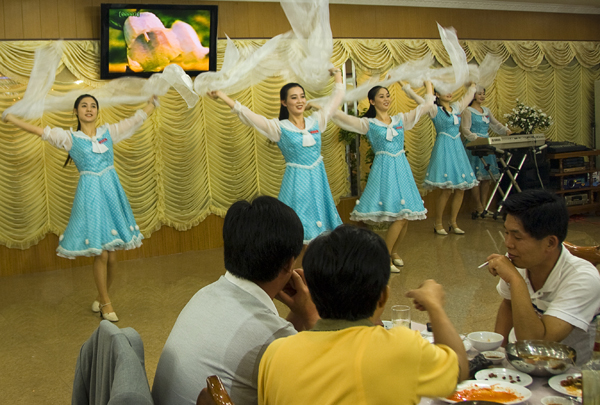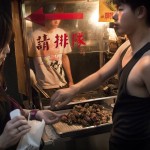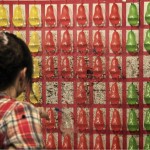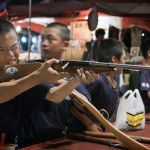North Korea announced it would dismantle its plutonium plant, supposedly ending its nuclear weapons program for good. In response, the United States took North Korea off its list of terrorist state sponsors — and I went to dinner.
Pyongyang Restaurant in Phnom Penh is owned and operated by the North Korean government, meaning all profits are sent directly back Kim Jong-il’s government, and now that North Korea is no longer a terrorist nation, I can enjoy my kimchi guilt free.
With a restaurants in Siem Reap, Phnom Penh and Sihanoukville, the totalitarian country’s foray into capitalism in Cambodia has been a runaway success. North Korea opened its first Cambodian restaurant in Siem Reap in 2003, and it was an immediate hit — especially with the growing number of South Korean tourists and businessmen.
Largely because of Norodom Sihanouk’s ties to North Korea, Cambodia has maintained diplomatic relations with North Korea, allowing the restaurants to set up shop. Sihanouk has been a regular resident of North Korea since being ousted in 1970 and has even befriended fellow movie-buff Kim Jong-il.
Estimates of the exact number of North Korean-run restaurants abroad vary but most put the number around one hundred. These restaurants play an important role in the North Korean economy, funneling tens of millions of dollars of foreign currency into Kim Jong-il’s coffers — necessary because the North Korean won is not convertible.

North Korean waitresses from Restaurant Pyongyang entertain patrons
While some North Korean-run restaurants in China blare propaganda films and plaster Kim Jong-il’s face on every possible surface, the restaurants in Cambodia are apolitical. In the Phnom Penh restaurant, customers can sit under a painting of a tiger with a disproportionately small head and watch a flat screen playing soothing films of North Korean waterfalls.
The food at Pyongyang Restaurant is expensive for Cambodia — US$6 to $22 per entrée — but it’s top notch Korean food. The ox-tail was tender, and the kimchi was both spicy and tangy. The restaurant also sells rare North Korean products like ginseng, honey and bear bile at outlandish prices. But people don’t just come for the bile.
At eight pm, the well-coiffed waitresses wearing identical pale blue, polka-dotted dresses and four inch heels take a break from serving to sing, dance and play traditional instruments. One waitress plays the electric keyboard, while the rest take turns belting out Korean songs. After doing the show day after day, the waitresses’ twirls and arm movements are perfectly in sync with each other, and the staff never stops smiling — ever.
By nine, the clientele, which had been enthusiastically drinking North Korean rice wine, started singing Korean karaoke with the waitresses. All of the servers are slim with faces pale from white make-up. All the waitresses have gone through a strict selection process in North Korea where they were chosen based on their appearance and loyalty to the government. Most of the waitresses are from well-connected North Korean families that could face retribution if their relative escaped. Despite this assurance, the waitresses are not allowed to explore Cambodia unattended. Somehow, this results in excellent service. Really excellent service. When I left, one grinning waitress sprinted across the restaurant to make sure she was there to thank me as I left.
Most people are not allowed into North Korea, but they can go to Pyongyang Restaurant and get a taste of the world’s most secretive nation.





